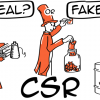Transcript
Can the planet take 1.5 billion new Apple iPhones each year?
Every year since 2015, 1.5 billion new smartphones arrived on the market. I know, they are not all iPhones but since Apple has been more aggressive about its environmental goals, for the sake of today’s video, I want to find out what it takes to make an iPhone and see if our planet can sustain so many smartphones. Or not. Ok, let’s get drawing!
Hi Alex, here. If you are like me and enjoy some rigour in your sustainability analysis (as opposed to looking at a bunch of things and hoping you didn’t forget anything in the end) then you are in the right place. Let’s look at an iPhone using these 4 sustainability conditions that have been peer-reviewed over the past 30 years to see what this product has to comply with to be sustainable: we will look at what is extracted from the Earth’s crust, what is produced by society, what physically degrades nature and finally the social aspects.
First, let’s look at how an iPhone contributes to systematically increasing concentration of substances extracted from the Earth’s crust.
To come to life, an iPhone needs many mined materials. These include: gold, silver, copper, tin, tungsten, tantalum, silicon, indium, gallium, arsenic, boron, phosphorous, antimony, cobalt and some rare earth elements such as Terbium, Yttrium, Gadolinium, Europium, Neodymium and Praseodymium. And yes, they all need to be extracted from the Earth’s crust. But it is the concentrations we are interested in here. And these materials are not all equal in nature. Silicon, for instance, is the most abundant element in the Earth’s crust and the natural flows via weathering and volcanic activity are very large. Even if we are extracting large amounts of if for our electronics (you’ve heard of the silicon valley), we are not systematically increasing its concentration in nature. That’s good news! Copper, silver, antimony, phosphorus, on the other hand, we are extracting so fast that they accumulate in nature which makes them a major issue. Tin was partially addressed in the iPhone 11.
Carbon is another issue. Mainly in the form of carbon dioxide and methane. Your iPhone has a role in that because of the energy it takes to manufacture and then to use it. When the energy is produced via burning fossil fuels such as petroleum, coal or natural gas, it contributes to the systematic increase of the concentration of carbon in the atmosphere. The environmental report for the iPhone 11 claims that the final assembly is done with 100% renewable energy (using hydroelectricity). That’s great, but what about the energy to extract the materials and create the components before assembly? Let’s go back to our silicon that was not an issue from a concentration perspective: it is made by heating quartz in an industrial furnace at 2000°C and it takes 10 to12 MWh to create a ton of silicon. China is the largest producer of Silicon and 65% of China’s energy comes from coal, the burning of which releases significant carbon into the atmosphere and contributes to climate change.
There is also a lot of aluminum in the iPhone which, similarly to silicon, is not an issue from a concentration perspective but from the energy it takes to extract and process.
All the mined materials in your iPhone have an energy cost to them.
Carbon is also used to make all the plastic parts in the phone. We will talk about these later in our third condition.
For your iPhone to not contribute to systematically increasing concentrations of substances extracted from the Earth crust:
materials would have to be kept in a technical loop so they don’t build up in nature
materials would have to be produced with energy that does not involve the extraction and combustion of fossil fuels at any point in its life cycle.
Hey, you are still here 🙂 Now, let’s look at how our iPhone contributes to systematically increasing concentrations of substances produced by society.
When it comes to greenhouse gas emissions, the environmental report for the iPhone 11 claims that it creates 72kg of CO2 equivalent through its entire life cycle (79% for production, 3% for transport and 17% for use). Although it does not look like much, this would have to be 0 or under to comply with our second condition. This could be achieved by offsetting the emissions (as Apple is starting to do) as long as the energy production still complies with our first condition (no fossil fuels). See, without the first condition, we could become sustainable only with carbon offsets but in reality, we can’t. The good news is: you can take care of the 17% by using only hydro, wind or solar power to charge it since, according to IPCC, these are the lowest carbon emission producing technologies.
Another way an iPhone can contribute to producing substances faster than nature can cope with occurs during the extraction of minerals and, in particular, the rare earth elements we mentioned earlier (used for screen and the magnets in the speaker). In many cases, it takes a lot of acid and other toxic chemicals to extract the materials from their environment and isolate just 1% or less. The 99% left is dumped into nature and by doing that over and over again, our iPhone contributes to a systematic increase in concentration of substances produced by society.
How can we avoid it? By cleaning up and by doing it slowly enough so nature can regenerate and clean itself up and avoid the accumulation of man-made chemicals. We can also use rare earths elements that are already extracted, which Apple started doing: the iPhone 11 environmental report mentions that it is made with 100% recycled rare earth elements in the Taptic Engine. Although this is only 25% of the rare earth used in the final product this is still progress toward a closed loop system.
Nature can take thousands of years to break down plastics so the plastic parts in the phone have to be 100% recycled to not accumulate in nature.
It is complicated, right?! I know. But if you want to manufacture and use such a complicated product, in my opinion, you have to be ready to do it right.
Now, let’s look at how our iPhone contributes to systematical degradation of nature by physical means.
All the excavation sites to extract the elements mentioned before fall under this category. Animal life and ecosystems are, at best, disrupted, and at worst destroyed through these processes. To avoid this, we need to make sure they are kept clean, uncontaminated and restored after the elements are extracted.
To comply with this condition, we also need to make sure that our iPhone does not end up in a landfill where it would deteriorate the local ecosystem and potentially contaminate ground water.
Although there is no scientific consensus yet, scientists have suggested that cell phone radiations may have an impact on bees and birds. As a precautionary principle, we should check that our iPhones are not systematically degrading nature that way. There is also the question of fibre used in packaging but we’ll focus only on the phone today.
Finally, how is our iPhone contributing to conditions that systematically undermine people’s capacity to meet their needs?
To wrap up with materials extraction, this is where we talk about the infamous conflict minerals: tin, tungsten, gold and tantalum. The mining and trade of these has helped to finance armed groups in the Republic Democratic of Congo and other places. A few dollars from our gadgets can contribute directly to people in these regions not being able to meet their needs. American companies now have to report the source of their conflict minerals. This is probably why Daisy (Apple’s disassembling robot for the iPhone) was designed to collect and recycle those 4 elements, among others.
Does the manufacturing of your iPhone expose people to dangerous working conditions or insufficient wages to meet health care needs? We know it can be challenging to totally control working conditions in far away places, especially when you deal with so many suppliers and third party organizations like Apple does for the iPhone.
How about using your phone every day? Can the extensive use of the screen be addictive and systematically make you feel less mentally and emotionally healthy? 66% of smartphone users are addicted to their phones according to a Trendhunter study.
Do you find that it stops you from being present with your loved ones? Again, I don’t have the answers to these questions, but the social aspect is certainly part of the sustainability analysis of the product.
So, can the planet take 1.5 billion new smartphones every year? Unfortunately, the answer is “not even close”. We are only contributing more to climate change and digging into our natural capital as opposed to living off the interests right now. And it is not even clear that they make us happier.
From a sustainability perspective, the problem is not that all the things mentioned before are done once. It is their systematic nature that make them unsustainable. The fact that we manufacture billions of these products and that our entire society is built around them.
The world would need more than 1000 Daisy robots to recycle the 1.5 billion new smartphones brought to the market every year. And, as Greenpeace pointed out, shouldn’t Apple focus on earlier stages in the product life cycle, such as making iPhones repairable and upgradable? Maybe Apple should lease the phones instead of selling them and be responsible for the entire life cycle. A the end of the day, it will come down to this question “Is Apple prepared to sell fewer phones to do the right thing?”
But there is something all of us can do: act responsibly. We can buy a second-hand phone, make do, repair the one we have and make sure that, when it does reach the end of its life, it goes back to Apple.






